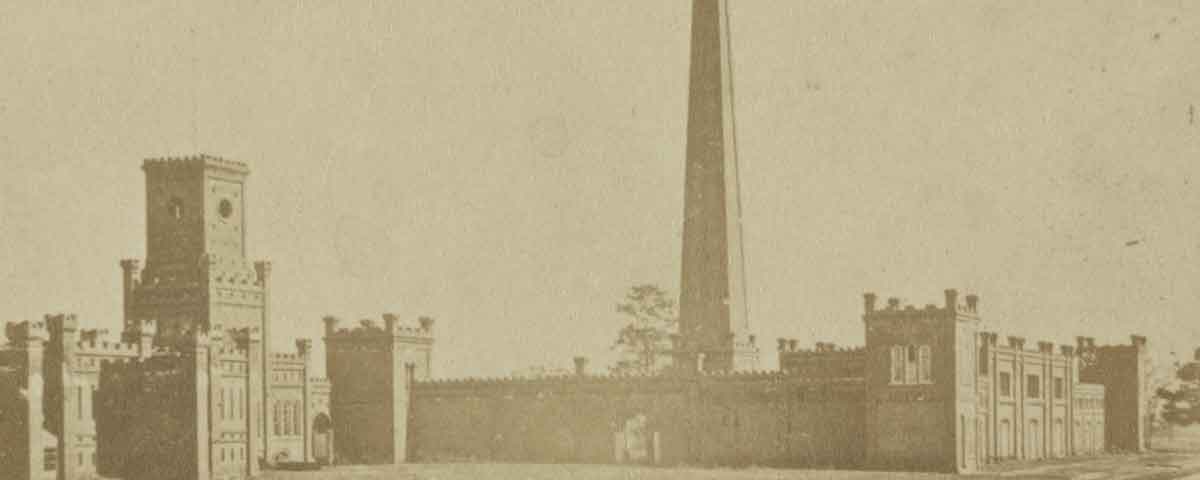A bearded Confederate colonel walked slowly to a tall flag pole and looked up at the oversized garrison banner snapping in the brisk afternoon breeze. It was late April 1865. President Jefferson Davis was escaping south, and the corpse of Abraham Lincoln was heading by rail to its final resting place in Illinois. With a heavy heart, the officer slowly hauled down his beloved flag. That act and a final order extinguished furnaces and brought the machinery that had run the Augusta Powder Works for more than three years to a disquieting halt. Colonel George Rains stood alone in the silence, gazing down the banks of the empty Augusta Canal that had sent his precious gunpowder to the armies of the Confederacy.
[quote style=”boxed” float=”left”]“To enter a great war without a supply of this essential material was appalling”[/quote]
[dropcap]W[/dropcap]hen Southern batteries opened on Fort Sumter on April 12, 1861, the young Confederacy’s entire supply of the gunpowder was barely enough for one month of active operations. The North was well-equipped to produce and supply its armies with gunpowder, but the Confederacy boasted only four small private mills (two each in South Carolina and Tennessee) that could barely keep up with local needs. “To enter a great war without a supply of this essential material,” Colonel Rains would one day write, “was appalling.”
Jefferson Davis and his chief of ordnance, Major Josiah Gorgas, unlike so many others, anticipated a prolonged and arduous conflict. But where could the Confederacy get its gunpowder? There was no effective or reliable means to procure it from abroad. The only viable solution was to construct a facility of sufficient magnitude to satisfy the needs of a nation at war.
Acting with celerity and sound judgment, Davis made the most important and impactful executive decision of his entire presidency: He selected Rains, then a major, for the thankless task of overseeing the Confederacy’s construction of a massive gunpowder production facility. A firm understanding of Rains’ education and work background is critical to appreciate what he would soon accomplish.
George Washington Rains was born in the New Bern, N.C., in 1817, a brother of future Confederate General and torpedo expert Gabriel Rains. He obtained an appointment from Alabama in 1838 to West Point, where he graduated first in scientific studies and third overall in the talented Class of 1842.
With a fresh commission as second lieutenant in the Engineer Corps, Rains garnered practical engineering experience constructing Fort Warren in Boston harbor. The monotony of such tasks bored the adventurous officer, who finagled the equivalent of a demotion by transferring to the 4th Artillery in 1843. After a year at Fort Monroe, Rains accepted a position as assistant professor at West Point, where he taught chemistry, geology, and mineralogy.
Rains resigned his position when the Mexican War began and rejoined his artillery regiment. He initially oversaw the Quartermaster’s Depot at Port Isabel, Texas, but spent most of the war serving as aide de camp to General Gideon Pillow. The North Carolina native was brevetted twice for bravery under fire, and was the first American to enter enemy-held Veracruz, where he negotiated the exchange of prisoners.
After the war Rains served at Fort Hamilton in New York, where he met and married Francis Ramsdell, the daughter of a wealthy Northern industrialist. Six months later he resigned from the Army to become president and partner (with his father-in-law) of the Washington Iron Works in Newburgh, N.Y. There, he obtained patents relating to steam engines and boilers, managed a large number of employees, and acquired practical manufacturing and inventive experience. Rains’ resumé by the time of the Civil War included combat, staff, quartermaster, and diplomatic experience, together with private sector manufacturing and management knowledge.
[dropcap]S[/dropcap]oon after the fall of Fort Sumter, Rains left New York for Richmond, where he was commissioned major of artillery in early July 1861. Once again he found himself in uniform, only this time it was Confederate gray.
Davis placed a nearly impossible task on Rains’ shoulders: Search the Confederacy for a central location upon which to construct a powder mill, “of sufficient magnitude to supply the armies in the field and the artillery of the forts and coastal defenses.” With that carte blanche, Rains left Richmond on July 10, 1861, for what he described as a “rapid rail tour” of the new Confederacy. “I almost lived on the railroad cars,” Rains later wrote, “devising plans, examining the country for a location, hunting up materials…and employing more or less every available machine shop and foundry from Virginia to Louisiana.” He quickly focused on northeastern Georgia, for just 10 days later he settled upon Augusta as the home for his proposed complex.
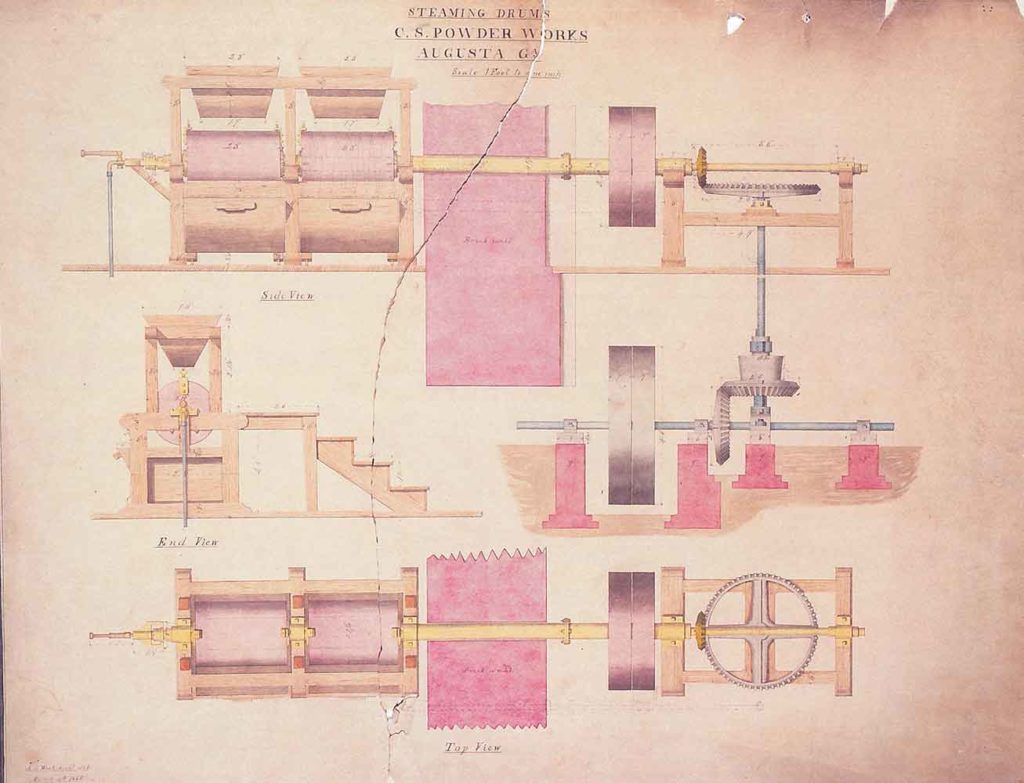
The Powder Works was constructed just west of the city between the Savannah River and the Augusta canal on the grounds of the old U.S. Arsenal. This part of Georgia offered a good central location deep within the Confederacy and safe from attack, and was well served by a river, canal, and the junction of two important railroads. Rains explained that the security aspect was especially important, “since the loss of the Works would have been followed by disastrous consequences.” The course of the war proved the brilliance of this decision. Rains was also tasked with satisfying the needs of Albert Sidney Johnston’s nascent Western army while the mill was under construction. Johnston’s only source of gunpowder was the unreliable and small Sycamore Powder Mill in Nashville that was unable to meet his needs. Other than a small amount of saltpeter and sulfur (two of the three elements composing gunpowder, the third being charcoal), Rains had nothing to send.
Working closely with Tennessee Governor Isham G. Harris, Rains contracted with local suppliers of niter to increase the production of saltpeter. He personally visited scores of niter-producing caves, reorganized and extended their mining contracts, and wrote and published a pamphlet titled “Notes on Making Saltpetre from the Earth of the Caves” to more efficiently excavate the precious mineral upon which so much hung in the balance.
By October 1861, a Nashville refinery was turning out 1,500 pounds of saltpeter a day, which was produced into gunpowder at the Sycamore mill. Rains utilized this small manufactory as a “school of instruction” for workers he later sent to Augusta. Rains also sent Sycamore’s machinery to Georgia in February 1862 just before the Union occupied the area. His prompt action saved the Confederacy irreplaceable equipment that would otherwise have been permanently lost. Throughout these early months Rains also worked closely with C. Shaler Smith, an architect and civil engineer who Rains described as “a genius of high order.” Smith developed architectural plans based on the various sketches and diagrams Rains mailed him.
With an engineer’s eye for precision and in a sound, scientific manner, Rains began construction in September 1861 on what would evolve into a two-mile-long series of buildings along the Augusta Canal that coincided with the manufacturing sequence for gunpowder. The warehouses for the raw materials were first in line, and the refinery next. The magazine that housed the finished product was located at the end of the complex. With the canal as a mode of transportation, the result was one of the earliest examples of an assembly line mode of production on a grand scale.
[dropcap]W[/dropcap]ith no prior experience manufacturing gunpowder, Rains relied upon a scholarly English booklet that explained the complicated process. Unfortunately, it did not elaborate on the type of equipment required, or the design of the buildings to house it. As Rains later explained, “I was thrown upon my own resources to supply these deficiencies.” The Augusta Powder Works began producing powder on April 10, 1862, just seven months after construction began. The cost was only $385,000—a bargain by any measure. It was the second largest powder mill in the world, and largest single Confederate industrial project of the entire war.
The first and principal structure erected was the refinery. The central portion held the refinery proper, while the eastern and western wings housed, respectively, a 1,500-ton saltpeter and sulfur warehouse and a laboratory for testing gunpowder. This colossal brick structure, 250 feet wide and 275 feet long, also contained machine shops and a charcoal department, complete with equipment for extracting precious saltpeter from damaged gunpowder. As a reflection of its importance, Rains patterned it after the English House of Parliament, complete with four square corner towers housing the mill’s offices. Centered on a 150-foot grandiose obelisk, the refinery looked more like a European castle than a 19th-century manufacturing facility.
The mixing house, or as Rains called it, the “Incorporating Mills,” stood directly east of the refinery. This 296-foot rectangular building held a dozen separate mills, each consisting of an iron circular flat bed seven feet in diameter, upon which massive rollers ground (“incorporated”) the powder.
[quote style=”boxed” float=”left”]Ordnance chief Josiah Gorgas hailed Rains’ mill as ‘far superior to any in the United States’[/quote]
A subterranean archway extending along the entire mixing house held an immense iron shaft nearly 300-feet long. This engineering marvel, together with its spur wheels and gears, was powered by a 14-ton 130-horsepower steam engine and boiler system built in the North before the war. The sulfur-saltpeter-charcoal mixture was ground under the huge mill rollers for one hour, at which time it was “brought to the condition of finished mill cake, ready to be cooled and granulated.”
The Incorporating Mills were ingeniously constructed to minimize the damage of a chance explosion. Three sides of each mill were constructed of brick and stone, but the fourth was made of light wood and glass. Each mill faced in an alternate direction so a blast in one would blow out the wood and glass side easily and contain the damage to a single mill. Rains also installed a forerunner of the modern sprinkler system: 12 large containers of water, one in each mill, all connected by a single iron shaft.
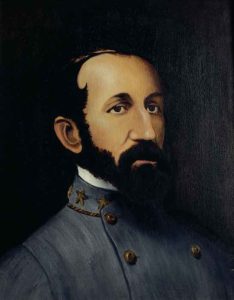
“Thus,” wrote Rains, “on an explosion in one mill, its bed plate was instantly drenched with water, and this caused the same to take place at the same moment with all the others.” An ingenious oak rail trolley car system shuttled the mixed powder through the next steps of the manufacturing process.
On the opposite side of the canal 100 yards from the mills were four cooling magazines, where the warm damp blackish gray mill cake cooled and hardened. A permanent cooling magazine was later built on the same side of the canal 500 yards east of as the mills. All of the permanent buildings were built mainly of brick and stone because the damp atmosphere surrounding the canal speedily decayed other materials. Next in line was the Press House, where the hardened powder was stamped into solid cake with the aid of a large pair of hydraulic presses manufactured in Richmond. This step was eventually bypassed when it was discovered that the weight of the mill rollers adequately pressed the powder mixture.
After the cooling stage, the gunpowder was sent across the canal to the Granulating Building, where the mill cake was broken into fragments by bronze toothed cylinders and vibrating wire screens. This separated the grains according to size and delivered them into their respective receptacles. The larger grains were used for artillery pieces, while the smaller grains were processed for shoulder arms and pistols.
The drying phase was the next step in the process. Rains’ ingenuity reduced the complicated three-step process into one. The use of revolving cylinders and blasts of hot air to dry, dust, and glaze the grains in a single operation saved an enormous amount of time and labor. With an emphasis on safety, the furnace and boiler were housed in a brick building 200 yards from the drying facility. The chimney was another 100 yards removed so sparks would have to travel 300 yards in order to reach the fireproof metal roof of the Drying House. This was especially important because gunpowder was at its most explosive state at this stage of the process.
The finished high quality gunpowder was weighed and packed for shipping in a building 500 yards farther down the canal. In dire need of a safe mode for transportation, Rains used a strong wooden box of his own design. “These powder boxes,” he explained, “were superior to barrels, being stronger, occupying less room, standing transportation better and safer in use.” The boxes were stored in a 100-ton magazine another three quarters of a mile up the canal. Ordnance chief Major Josiah Gorgas, never easy to please, hailed Rains’ mill as “far superior to any in the United States and unsurpassed by any across the ocean.”
The first element necessary to produce gunpowder is saltpeter (niter). The raw niter from the limestone cave mining industry contained impurities that absorbed moisture and weakened the gunpowder. To combat this, Rains developed a method to refine it to nearly absolute purity. Instead of successive crystallizations and washings, he boiled, cooled, crystallized, and washed it in one long step with the use of special equipment instead of numerous workers. This speedy method enabled the Augusta mill to refine between 8,000 and 10,000 pounds of saltpeter per day.
The next essential element is sulfur, which also must be chemically pure to make reliable gunpowder. Unlike every other powder mill of its day, the Augusta facility utilized a two step distillation process. Rains boiled the sulfur and poured it into wooden boxes five-feet tall and 10-inches square. The impurities sank to the bottom, leaving the top three feet pure. The top “cone” was broken off and distilled, which resulted in sulfur “a beautiful citron yellow when cold, and entirely pure.”
Charcoal is the third and final element needed to produce gunpowder. Once again Rains employed a distillation process. Unable to procure enough willow wood, from which charcoal was usually produced, Rains experimented with cottonwood, which was readily available in northeastern Georgia. The wood was heated for two hours in huge iron cylinders and pulverized into a fine powder in barrels filled with bronze balls.
The charcoal, saltpeter, and sulfur were then shipped to the Weighing House, where the three elements were commingled in a proportion of 45 pounds of saltpeter to 9 pounds of charcoal to 6 pounds of sulfur. The mixture was moistened and ready for the next step of the manufacturing process previously described—the Incorporating Mills. Once finished, the powder was shipped via railroad to all points of the Confederacy.
Heavy expenditures of gunpowder, including coastal operations and routine skirmishing, together with the steady loss of the niter caves to advancing Union armies, compelled Rains to devise better manufacturing techniques to maximize the quantity and quality of his powder. One example was a new process for combining charcoal and saltpeter. Rains placed a piece of charcoal under a microscope and discovered that the particle was riddled with tiny pores. As he later explained, “the charcoal by its combustion with the oxygen of the saltpetre supplied the expanded gasses which produced the explosive force.” Rains boiled the mixture for eight minutes in copper cylinders, which filled completely each tiny pore with saltpeter. The result was astonishing: The quality of the gunpowder increased, and the timely incorporating mill process was cut from four hours to only one—practically quadrupling the mill’s capacity.
Rains also commanded the August Arsenal and its various machine shops, making the Augusta mill complex the heart of the Confederate war machine and the most indispensable of the South’s limited number of manufacturing centers. If it was captured or destroyed, the effect on the Southern war effort would have been almost instantly fatal.
If his duties were not enough, Rains also commanded the 1st Regiment Georgia Local Defense troops, essentially old men and young boys arranged into infantry companies, plus a battalion of cavalry and a battery of artillery. 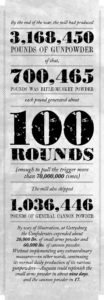 Those troops were trained as early as 1862 to man the light earthworks constructed around the city. The power mill wasn’t seriously threatened with capture or destruction until the opening of the Atlanta Campaign in May 1864.
Those troops were trained as early as 1862 to man the light earthworks constructed around the city. The power mill wasn’t seriously threatened with capture or destruction until the opening of the Atlanta Campaign in May 1864.
The hazard of an internal disaster was much more likely. Rains widely separated the buildings and left in place shock-absorbing pine trees. He posted sentinels in key locations and mandated workers wear rubber-soled shoes. Still, the facility suffered four explosions of varying magnitude. Three occurred in the Incorporating Mills. The most devastating blast, however, took place in a temporary building near the canal a few months after the works began operating. Rains described the explosion with cool detachment: “There were seven men within the structure, a sentinel outside, and a boy with a mule in a shed adjoining. The bodies of the seven men and the boy, with the debris, were carried up with the ascending column, and by its revolving action, reduced mainly to small fragments and dispersed. The sentinel was killed by the shock, but his body was not otherwise disturbed.” The deadly blast was the work of a single match carelessly dropped by one of the workers who was known to smoke on the job when the foreman was absent, as he was that fatal day.
Another threat to the smooth operation of the powder mill was the fluctuating stability of the local labor supply, both skilled and unskilled. Faced with cutthroat wage bargaining as a result of the severe labor shortage, Rains combed hospitals for workers while exhorting the authorities in Richmond for furloughed soldiers unable to stand the rigors of the field. These labor problems, coupled with the deterioration of the South’s railroad system, dramatically worsened in the spring of 1864, when William T. Sherman moved out against Joseph E. Johnston in northern Georgia. The Atlanta Campaign signaled the beginning of the end of the smooth operation of the Deep South’s ordnance network, and posed an immediate existential threat to the Augusta Powder Works and the Confederacy.
In the August issue of Civil War Times, Ted Savas will continue his examination of the Augusta Powder Works, and argue that William T. Sherman’s failure to target Augusta between July 1864 and early 1865 was perhaps the Union’s major strategic blunder. Savas writes from California and is the managing director and co-owner of Savas Beatie, LLC, a publishing house that specializes in Civil War books.
Black Labor and
Black Powder
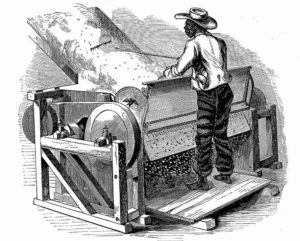
(Photo12/UIG via Getty Images)
A large enslaved black work force toiled at the Augusta Powder Works with little or no white supervision to help produce and distribute gunpowder. Their contribution to the Confederate war effort was enormous.
Surviving records kept by William Pendleton, the superintendent of the powder works, begin on November 7, 1862, seven months after the mill began operating. The records explain the type of daily work performed and the number of workers in the mill, but do not differentiate between enslaved and free until August 28, 1863.
In April 1862, white men comprised about two-thirds of all workers and held the vast majority of skilled positions (machinists, coopers, masons, etc.). African Americans held nearly all the unskilled positions (grading roads, hauling powder, work in the stables, etc.) By late August 1863, when the first records to mention race appear, 53 men worked at the mill (27 white and 26 black). Of the latter, 93 percent performed unskilled labor.
The most demanding physical assignments were done exclusively by blacks. White unskilled mill workers, who at no time numbered more than four hands per day, were assigned to clean and oil engines, ship powder, or work in the stable.
As the war continued, the Conscription Bureau routinely picked off Rains’ skilled white men. That left Rains with no choice but to fill the skilled positions with African American men.
By the end of 1863, black workers performed 48 percent of the skilled positions. During the first quarter of 1864, an average of 26.2 percent of black labor was utilized in skilled jobs, but that number shot up once more to nearly 42 percent during the second quarter of 1864, and nearly 47 percent for the third quarter. The approach of Sherman’s armies and consequent dismantling, transfer, storage, and rebuilding of the mill consumed much of November and December, which skewed the end-of -year percentages, but in October, 40 percent of all the skilled artisans were black.
A look at the last months of the war in 1865 also proves instructive. In January, skilled black artisans comprised 45 percent of the labor force. The mill was stopped and partially packed again in February, but surviving records put the number of skilled blacks at 38 percent, and in March it was still at 37.5 percent. The number fell to 21 percent during April, the war’s final month. The declines were the result of the assignment of African-American workers in large numbers to repair destroyed rail lines and build roads so Rains could ship gunpowder.
Many of the skilled tasks required a hands-on role in the production of gunpowder. For example, black workers often spent the day “burning charcoal,” which meant operating the critical Charcoal Refinery. That required filling a metallic slip cylinder with a precise amount of wooden sticks, heating them for a specific length of time to a certain temperature, operating cranes to place the hot cylinders into large cooling retorts, submerging them into water baths, and carefully sorting the finished product. According to Pendleton’s conscientious daily entries, white laborers were never assigned to this department, which means these important functions were performed without any white supervisors.
During the last days of January 1864, blacks were assigned for the first time to run the difficult and delicate Saltpeter Refinery. Again without direct white supervision, these men boiled the saltpeter in large copper kettles, cooled down the “mother liquor,” and crystallized and washed the mineral in multiple complex steps. Other black workers used scales to precisely weigh saltpeter and repair machinery.
Rains usually turned to his black labor force for assistance with the mill’s vital oak rail track system. These men made the nails and bolts that held the track together, and worked on the wooden track or push trucks themselves. There is no mention or record of the system ever having failed, even for a single day. Nor was there a single act of sabotage or destruction recorded anywhere within the sprawling facility.
The records are indisputable. Black workers assumed the place of absent skilled white artisans in large numbers, and played a vital role in producing the gunpowder intended to keep them in shackles.—T.P.S.

